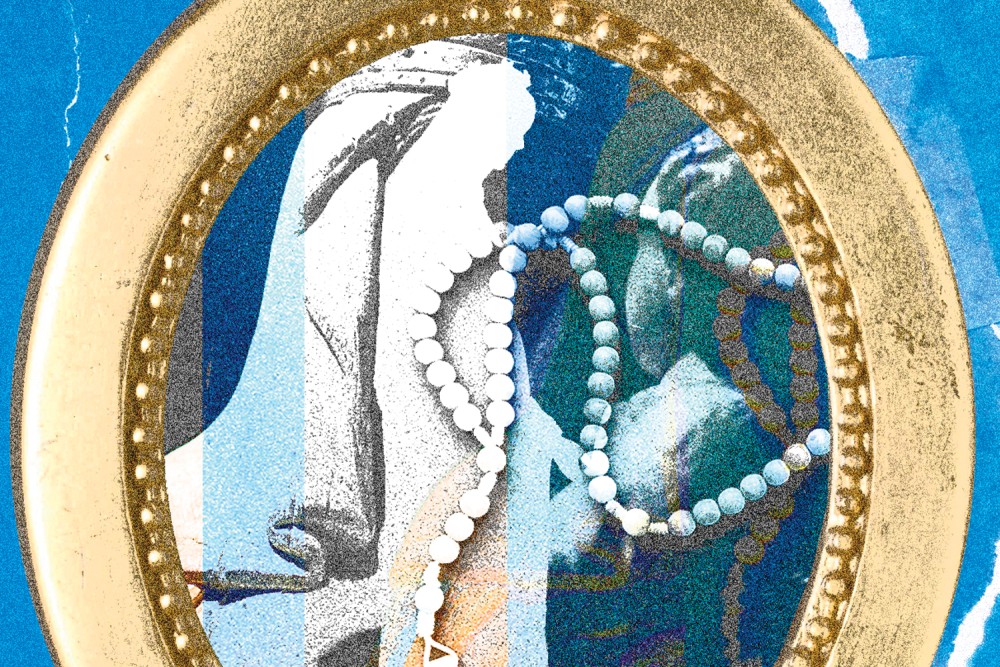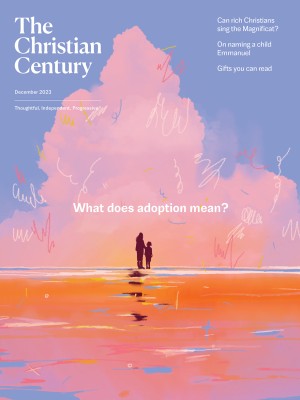My struggle with Mary
Can Jesus’ mother be redeemed from the church’s tendency to parcel her up into a patriarchal box and then label it “glory”?

(Century illustration)
I’m not the first and I won’t be the last person to have an ambivalent relationship with Mary, the mother of Jesus. There have been times in my life when I’ve held a significant personal devotion to her. I found comfort in praying the rosary. Even now, decades on from using the rosary as a dedicated focus for prayer, I continue to be moved by its acknowledgment that “the Lord is with” Mary, as well as its recognition of her eternal ministry of prayer: “Pray for us now and at the hour of our death.” The idea that Mary is the queen of heaven is one to conjure with. It feeds my poetic imagination.
Yet it is also fair to say that Mary can be a turnoff. She has been held up, especially by the Catholic Church, as the ultimate role model for women, the icon of femininity. In the rosary, Mary’s value is shaped around her motherhood: “Blessed art thou among women, and blessed is the fruit of thy womb, Jesus.” If I am indeed in awe of Mary as the theotokos—the God bearer—many feminists remind us that when Mary’s blessedness is framed merely in terms of her motherhood, this can be bad news for ordinary women.
Read our latest issue or browse back issues.
In her classic essay “Stabat Mater,” Julia Kristeva points out how the church’s genius for making Mary the icon of faithful womanhood is a double-edged sword: Mary gives women an image of holiness and female power to which to aspire, yet one which no woman can actually achieve. For no ordinary woman can bear a child and remain perpetually sinless.
In a world with few female role models, Mary runs the risk of setting women up to fail: insofar as she has been used to convince women that their holiest identity is to be mothers, she also shows how far short actual women fall of “ideal” motherhood. Certainly, for very many women who cannot bear children, including me, the way in which Mary the mother is held as an icon for women has felt oppressive.
I feel as if Mary’s humanity has often been eroded away. So many statues and paintings of her are sentimentalized. She is presented as a middle-class simpering White woman dressed in pristine blue robes. In emphasizing her virginity and suggesting that she was sinless, traditional ideas about Mary redact out the facts of her female body.
More than that, there are reasons to be troubled by some of the biblical representations of Mary, especially in this age of questions around consent. In the famous encounter between the angel Gabriel and Mary, Gabriel announces that the Holy Spirit will come upon Mary and “overshadow” her so that she shall bear God’s son. Feminist analysis of this encounter has ranged from concerns about the extent to which Mary is set up as a compliant handmaid to questions about whether she is old enough to grant her consent to God’s plan.
It doesn’t take much imagination to see how, for some, the images created by this encounter are troubling. A girl meeting the majesty of God, represented by an angel, is one thing; a girl being told she will conceive a son via the overshadowing power of the Holy Spirit is another. One can readily see how it is possible to read God’s call on Mary as massively skewing power toward God.
Can Mary be redeemed from the church’s tendency to parcel her up into a patriarchal box and then label it “glory”? I think so. In The Book of Mary, poet Nicola Slee expands the frame of imaginative reference. Her poem “In Praise of Mary’s Hairy Armpits” invites the reader to keep sight of Mary’s holiness whilst presenting her as a woman with emotional ups and downs, body odors, and periods.
In “An Artists’ Litany to Mary,” Slee takes the familiar claim that Mary is queen and expands it: not simply queen of heaven but queen of poets, fools, and clowns. The poem re-centers God’s making to the feminine: the Word who was from the beginning and through whom all things are made is refracted through the figure of the queen of all creativity. The one who carries God in her womb becomes the locus for poetic and priestly creativity. Slee links Jesus’ royal priesthood to Mary’s queenly authority and creativity.
I acknowledge that the annunciation can be read as an unsavory encounter between power and vulnerability. Gabriel’s encounter with Mary raises questions about consent and agency, questions I do not underestimate. Yet I also find Mary’s response to the angel significant: Mary’s willingness to unite her will and purposes to those of God is no mere afterthought. There is an extraordinary, quiet, and deeply prophetic determination when Mary says, “Let it be with me according to your word” (Luke 1:38). She joins a long line of those who take their place in God’s work of justice and love. Mary speaks and claims her place. She will not simply be done to. She transforms God’s invitation into service and action.
Mary is a peasant girl daring to speak to God’s ambassador. A girl with no voice and little agency, she has courage and finds her own authority. When she meets Gabriel, she may not yet realize it but she has all the authority of a queen. As she embraces God’s invitation to be the theotokos, she finds her prophetic voice. A few months after her encounter with Gabriel, Mary will proclaim her famous Magnificat. Her words of justice, comfort, and challenge echo down the ages and shape us still. The young girl who met the presence of God continues to disrupt and transform our troubled world.






